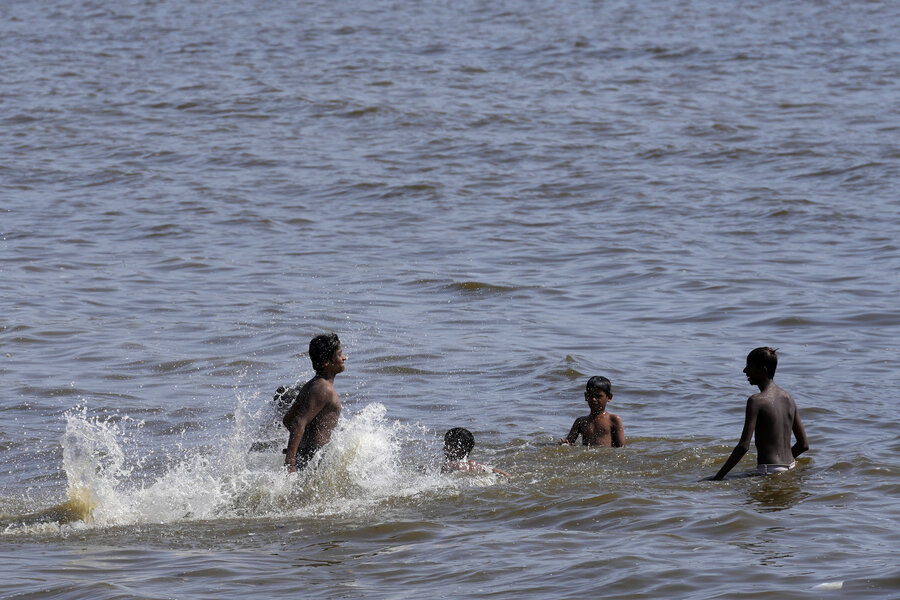Global heatwaves are getting hotter. How can risks be curbed?
Loading...
| London
Heatwaves are breaking records around the world, from India and Thailand to the normally mild U.S. Pacific Northwest, with scientists predicting that global average temperatures will likely surge to record levels in the next five years. In particular, the combination of a new El Niño weather pattern starting this June and the continued release of climate-changing emissions will “push global temperatures into uncharted territory,” scientists predicted in a report released on Wednesday. “This will have far-reaching repercussions for health, food security, water management, and the environment. We need to be prepared,” warned Petteri Taalas, secretary-general of the World Meteorological Organization. Here’s how climate change is contributing to new global heat extremes – and human risks:
Is climate change the main driver of new heat records?
Yes. Climate change is fueling a range of extreme weather around the world, from flooding and storms to droughts, but the change it is most clearly producing is more extreme heat. A record-breaking heatwave across India, Bangladesh, Laos, and Thailand in April 2023, for instance, was at least 30 times more likely because of climate change, scientists from the World Weather Attribution group said on Wednesday. Continued use of oil, coal, and gas to power homes, cars, and the world’s economy results in the release of gases that blanket the planet, trapping ever more of the sun’s energy in the atmosphere rather than letting much of it escape. About 90% of that excess energy – or heat – has so far been absorbed by the world’s oceans, moderating temperature increases. But ocean surface temperatures are now at their highest level ever recorded, scientists say. They fear seas may be reaching the limits of their heat-absorbing abilities, which could mean more heat stuck in the atmosphere – and soaring thermometers.
Why are heatwaves dangerous?
Many people look forward to hot summer temperatures, and photographs on sweltering days often show people at the beach or splashing in fountains.
But heat can be deadly, and many people are unprepared for the level of heatwaves that are now appearing and that are predicted in the future, scientists say. Extreme heat stress has already doubled in the last 40 years, according to the U.S. space agency NASA. Especially in already humid places, when heat and humidity combine to produce a so-called “wet bulb” temperature above 35 degrees Celsius (95 degrees Fahrenheit), the human body can no longer effectively get rid of enough heat, scientists say. In such extreme heatwave conditions – which are becoming much more frequent around the world – those exposed can die without swift access to air conditioning, fans, or other cooling. Residents of already hot countries, from India to Iran, are at particular risk – but so are people in normally cooler places such as the U.S. Pacific Northwest, who may not understand the risks or have access to cooling technology. In 2021, a powerful heatwave killed at least 112 people in the U.S. state of Washington, with 1,400 dying across the broader region, including in Canada. In Europe, a series of heatwaves between June and August 2022 caused over 20,000 heat-related deaths, particularly in countries such as Spain and France, health agencies estimate.
How can risks from worsening heatwaves be reduced?
Building awareness that heatwaves are becoming increasingly deadly is a first key step, doctors and scientists say. Heat researchers have proposed giving heatwaves names, as now happens with hurricanes and storms, to emphasize the level of threat they present to people. Ensuring that those in the path of heatwaves have access to reliable cooling is also crucial – a problem when increased demand for cooling during heatwaves can spark power outages. Because growing use of air conditioning can drive more climate change and produce even hotter temperatures, finding low-carbon means of cooling – such as using wind and solar power to generate electricity – is crucial, scientists say.
Shifting work and school hours to cooler parts of the day and providing more breaks for workers can also save lives, scientists say, as can finding simple, low-cost ways to make homes and workplaces cooler, such as painting roofs white.
What happens if climate change isn’t curbed?
If oil, gas, and coal emissions continue and heatwaves worsen, especially hot parts of the planet could become uninhabitable, sparking mass migration and potentially large-scale deaths if people are unable to find respite from the heat.
Extreme heat could also spur other types of disasters, from water shortages as more water evaporates in hot conditions to worsening droughts, wildfires, and losses of nature.
Heatwaves could also hurt economies as workers – especially those toiling outdoors, such as farmers – find it increasingly difficult to do their jobs, or as heat-blighted crops fail, adding to the planet’s already growing numbers of hungry people.
This story was reported by The Thomson Reuters Foundation.







